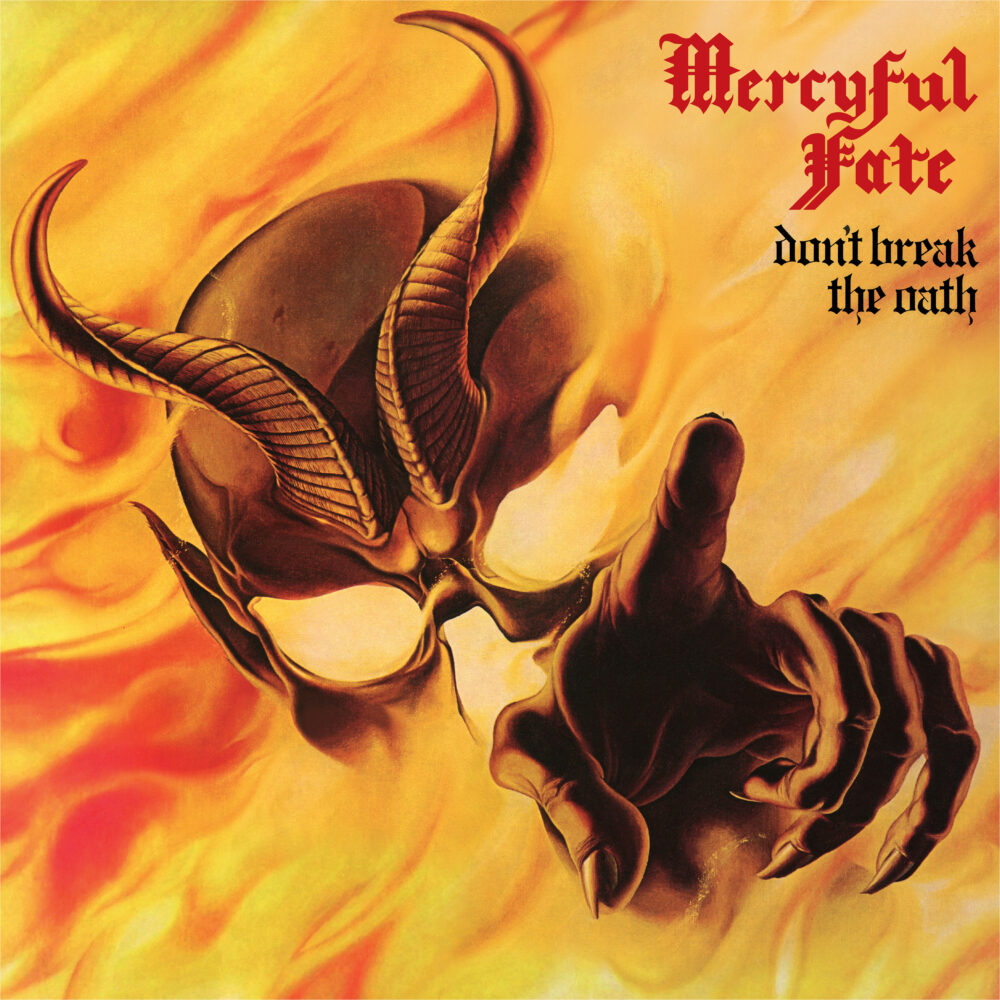The 2025 State Of Metal Address

This is not the Black Market. It couldn’t be the Black Market, because that column was shaped by the shared taste and sensibility of a group of writers whose collective voice I couldn’t emulate if I tried. I’m not Ian or Wyatt or Doug or Aaron or Michael (though I’ve been lucky enough to cross paths, both personally and professionally, with all of them). I’m Brad Sanders, and this is the first edition of a new metal column called Breaking The Oath.
You might have picked up on the Mercyful Fate reference in the name of this column. I hope that signals a few things about what will make Breaking The Oath distinct from the Black Market. First, I’m a dyed-in-the-wool devotee of classic heavy metal. I love bands who project what Rob Halford once called “the power and the majesty amidst the blood and steel.” I didn’t get into metal through extreme metal, nü metal, or punk; I got here through Iron Maiden. That’s going to be reflected in some of what I write about, though I also love a lot of the oddball stuff that Ian and the gang covered in the Black Market. I’ll try to strike a balance.
Secondly, and perhaps paradoxically given my previous point, I think metal orthodoxy can be stultifying, and while I did take a proverbial oath when I started listening to this stuff, I’m more than happy to break it. I’m listening to the new Deafheaven album as I write this, and I think it’s a hell of a lot more interesting than 99% of trve kvlt black metal that’s ever been released. In my past life as a label manager, I worked with acts like Thou and Uniform and the Body, bands whose music blurred the border between metal and its various hinterlands. That’s a part of me, too, and I hope it will be part of this column.
But enough preamble: Since this is a reset for the Stereogum metal column, it feels like a good moment to take stock of where metal is as we enter 2025. My fellow metalheads, the state of our metal is strong — with reservations. I won’t belabor the points made by Eli Enis in his seminal essay for this website, “Metal’s Stadium Class Is Less Metal Than Ever,” but the mainstream does indeed often feel like a wasteland, at least beyond the elder statesmen in Maiden, Priest, Metallica, and the like. (Bands also aren’t breaking through the way they once did: The newest metal-adjacent album on the Billboard 200 right now is Linkin Park’s Meteora, from 2003.) As bad as the early 2000s felt for metal at the time, we’ve backslid since then. Slipknot and System Of A Down became truly massive acts amid rock radio’s post-9/11 rallying around meatheaded, conservative butt rock. It’s hard to imagine that happening today.
Still, it’s not worth writing off metal’s mainstream potential entirely. Like any genre that hopes to survive as more than a museum, metal demands a constantly replenishing source of fresh blood. I don’t know how many kids are making the journey from Bad Omens and Beartooth to Black Sabbath, but the lineups of rock festivals like Sonic Temple here in my hometown of Columbus are at least offering them a fighting chance. This year, real-deal extreme metal is nearly as well represented on the lineup as the radio-friendly, lowest-common-denominator shit. Come for I Prevail, leave repping Acid Bath? Stranger things have happened, I suppose.
The place where metal seems to be making its most significant inroads with younger listeners, at least right now, is at the nexus of old-school death metal and hardcore. Whenever I go see a band like Sanguisugabogg or 200 Stab Wounds, I’m comfortably 15 years older than the average mosher there. That makes sense — hardcore is huge with kids today primarily because of its level of DIY accessibility and its raw, in-the-flesh physicality. Death metal, especially the more groove-oriented, less technicality-concerned styles, can offer a similar experience. Nobody who’s survived a Torture pit would argue otherwise. (I’m on the record as not getting Torture at all, but I probably have to chalk that one up to getting old.) In those rooms, I can feel the new lifeblood being injected into the scene. Gently headbanging to an old-man thrash band is one of life’s great pleasures, but it doesn’t feel like it’s moving anything forward. Watching a bunch of teenagers lose their goddamn minds to a chugging, drop-A riff does.
More common in metal in 2025 is the hyper-focused micro-scene, usually proliferating online rather than in physical space. Musicians in these scenes aren’t necessarily aiming for crossover success; they’re feeding a demand for a specific thing and building community through it. The raw black metal/dungeon synth scene is a good example. (Some acts blend the two styles; others play one or the other but aesthetically align themselves with the shared subculture.) There are hundreds, maybe even thousands of artists in that world who have popped up since the beginning of the pandemic, most of whom release their music on limited tape runs of as few as 25 copies. It’s almost impossible to be a completist of that style, but there are plenty of people who get obsessed and dive deep. I tend to skim the surface, looking for the standouts. But you can dive as deep as you want into any number of these micro-scenes. I listen to more traditional heavy metal bands with Conan the Barbarian-looking dudes on their album covers than I probably should. Maybe you really love technical brutal slam. To each their own.
If metal once looked like a tribe, with long-haired, black-shirted high schoolers trading acknowledging nods across the cafeteria, it’s a bit more complicated now. Metal’s increasingly specific subgenres have atomized the scene. A death metal fan might want nothing to do with black metal; my beloved power metal remains exceptionally niche in the United States. As a metalhead of what I’d like to think is discerning taste, it’s more likely than not that when a random person recommends me a band, I’m going to think they suck. There are simply too many bands, and too few of them that we all agree on. It was once pretty easy to scream “SLAAAAYER!” in a heavy metal parking lot and get a reciprocal reply. What do you think would happen if I screamed “LAMP OF MURMUUUUUUR”?
There’s also very little material solidarity among metalheads, despite exhortations from the likes of Bruce Dickinson, who gives a little unity speech at Maiden shows before launching into “Blood Brothers.” How can you be blood brothers, an LGBTQ metalhead might ask, with someone who wants you dead? It’s a fair question without a good answer. Metal didn’t arise out of a sense of political purpose the way punk and hardcore did, so its fans are more ideologically heterogenous. When I go to a metal show – especially one here in Ohio, and especially one for an older band – I’m in a room with more Republicans than at any other moment in my social life. Sometimes that feels cool, a throwback to a time when people across the political spectrum coexisted in mottled affinity groups. Other times, Blackie Lawless unfurls Trump banners during a W.A.S.P. concert, and it takes the trans frontwoman of the great band Sonja to blow the whistle on it.
Existing as a metalhead within the extremely-online leftist sphere, as I try to do, can also be difficult. There’s an arcane rulebook governing which bands and labels are “sketchy,” and you might be shocked to learn that it’s not just the ones that employ Nazis. Play six-degrees-of-shithead too loosely and you’ll end up on the wrong side of someone’s indignant tweet. After a week, nobody remembers what it was about. It’s an exhausting cycle that’s frequently left me thinking of a band I liked in 2015 and asking myself, “Wait, were they canceled?” The paper trail usually goes cold. I try to save my energy for the true pieces of shit that litter the scene, of which there are still too many. The guy who used to be in a band with the guy whose former label rep reposted a right-wing podcast isn’t on my mind too much.
Outside of the scattered regional scenes, online communities, and political cohorts that exist, artistic individualism is flourishing in metal. A lot of my favorite artists today are the ones who take advantage of the relative ease of recording and the democratization of distribution models to release a ridiculous amount of music. Now is the time of the true original, the epoch of the iconoclast. Ryan Clackner from Knoxville, TN and Ayloss from Athens, Greece have dozens of distinct musical personae between them; I’ve interviewed both men and discovered singular working processes that you simply can’t learn by hanging out at the metal bar. Erin Dawson, who records as Genital Shame, has built a small but mighty discography of deconstructionist black metal that feels like it’s giving birth to its own musical tradition—”trans woman black metal,” she calls it, with a wink but not totally in jest. I couldn’t tell you what Adam Kalmbach is doing on most of the albums he releases under the Jute Gyte name, but I find them all fascinating.
Take the list of new tracks below as evidence that metal is thriving away from the glare of mainstream attention. Five of the 10 songs were self-released by the artist, and only three of the bands exist within what I would call a traditional “scene.” (Two of those three are from Sweden, which publicly funds community music programs — for now, anyway.) There’s less institutional support for metal than ever, and at least anecdotally, normal people’s parents don’t even know it’s still being made. But metalheads have had decades of practice thickening their skin against slings and arrows. So what if there’s no remunerative or reputational incentive to make this music? Metal finds a way.
TEN NAILS THROUGH THE NECK
Gonemage – "Entranced By The Ice Storm"
Location: Dallas, TX
Subgenre: black metal/chiptune
Garry Brents releases a lot of adventurous music under a lot of different monikers, but for the past several years, Gonemage has been his flagship project. The last Gonemage full-length, Spell Piercings, sounded at times like a midpoint between Korn and Thorns; the Entranced By The Ice Storm EP trades most of the nü influence for a digitized blast of ’90s chiptune. The industrial black metal backbone remains intact, though, especially on the towering title track—one of Brents’ finest songs, under any name. [From Entranced By The Ice Storm, out now via the artist.]
Fleshbore – "Inadequate"
Location: Indiananapolis, IN
Subgenre: technical death metal
Tech-death tends toward a kind of quantized perfection that doesn’t typically do much for me, but the high degree of difficulty and full-throttle execution of Fleshbore’s Painted Paradise is hard not to admire. “Inadequate” is the easy standout, a cortex-melting track that climaxes with a high-on-the-neck bass solo from Cole Daniels that would make Geddy Lee blush. [From Painted Paradise, out now via Transcending Obscurity Records.]
Téleos – "Clamor Bestiae Rationalis"
Location: Santiago, Chile
Subgenre: melodic black metal
When we think about keyboards in black metal, we usually think of haunted-house organs or synthetic strings and horns. Téleos mastermind Mnemosynvus instead builds his melodic black metal around the rich, undistorted sound of a grand piano. It’s a masterful gambit, and on the Chilean project’s debut album, the keys often play co-lead with the churning guitars in a stirring approximation of a black metal piano concerto. [From Lvmen Deorvm Vltra Lvnam Sitorvm Tandem Evanescit, out now via the artist.]
Othaliël – "Douleur Inapaisable"
Location: France
Subgenre: avant-garde folk metal
The French musician Asthâghul has amassed one of black metal’s most unpredictable discographies under the name Esoctrilihum. Othaliël’s Ectrülhys marks the first time he’s felt the need to move one of his experiments out from under the Esoctrilihum umbrella, which alone would make it a fascinating artifact. With the same bewildering compositional freedom he displays in his main gig, Asthâghul tries his hand at a kind of atmospheric neofolk, using only 12-string guitar, nyckelharpa, piano, and synth. The harsh vocals are the album’s only tether to the commonly understood definition of “extreme metal,” but I defy you to tell me the 12-minute “Doueler Inapaisable” isn’t heavy as hell. [From Ectrülhys, out now via the artist.]
Time Rift – "Coyote Queen"
Location: Portland, OR
Subgenre: hard rock
Look, could “Coyote Queen” soundtrack an SUV commercial where a tattooed woman driving offroad in the desert stops the car to take a sunset photo of a snake coiled around the base of a cactus? Yeah, dude, it could, and that’s why it rules. Portland’s Time Rift made a big upgrade in the vocals department when they enlisted Nyx Division frontperson Domino Monet for sophomore LP In Flight, and “Coyote Queen” is the new pinnacle of their high-octane, riff-powered sound. RIYL Budgie, Royal Thunder, the intro song from Anthony Bourdain: Parts Unknown. [From In Flight, out now via Dying Victims Productions.]
Uulliata Digir – "Myrthys"
Location: Poznań, Poland
Subgenre: progressive/avant-garde metal
Let the record show that I found this album on my own! But I did get a Bandcamp email a few days later letting me know that former Black Market column steward Ian Chainey bought it as well, which makes perfect sense. Uulliata Digir play the kind of confounding, uncategorizable, formally ambitious metal that fans of the old column should find perversely comforting. “Myrthys” offers a whirlwind of clattering drums, a pair of vocalists meeting in syncopated semi-harmony, and a trumpet given to clanging, discursive solos. It’s a prime example of what Ian might have affectionately called “goo.” [From Uulliata Digir, out now via the band.]
Selvans – "Il Mio Maleficio V'incalzerà!"
Location: Abruzzo, Italy
Subgenre: orchestral black/heavy metal
A lot of my favorite metal is highly theatrical, and the third album by the Abruzzese maestro Selvans scratches my King Diamond-trained itch. (Per Metal Archives, Selvans is also a musical theater actor, and yeah, that tracks. I’d have killed to see him as Jacob Marley in Alan Menken’s A Christmas Carol.) Flanked by a 60-piece orchestra and choir credited here as the Coven, Selvans sounds truly massive in his effort to marry Monteverdi to Mortuary Drape. [From Saturnalia, out 1/31 via Avantgarde Music.]
Century – "Necromancer"
Location: Stockholm, Sweden
Subgenre: traditional heavy metal
Don’t go into Sign Of The Storm looking for Century to reinvent anything. The Swedes are slavishly devoted to the aesthetics of the early NWOBHM and its continental European offshoots. You listen to Century for execution, not innovation. Thankfully, Leo Ekström Sollelmo and Staffan Tengnér know that sound as well as anybody, and “Necromancer” is about as good as it gets: a sub-three-minute barrage of triumphant riffs, smoldering leads, and galloping, Clive Burr-like drumming. [From Sign Of The Storm, out now via Electric Assault Records.]
Sarcator – "The Deep Ends"
Location: Trollhättan, Sweden
Subgenre: thrash metal
I’ve spent the past couple years telling anyone who will listen that the best regional metal scene in the world right now is a cluster of teenage thrashers from Sweden. Bands like Eternal Evil, Atonement, Bloodstain, Venthiax (who nearly made this column with their new live tape The Omens Arrival), and Sarcator headline one of the precious few metal youth movements to emerge in the ’20s. Swarming Angels & Flies is already Sarcator’s third album since 2020, and it boasts mainman Mateo Tervonen’s sharpest songwriting yet. Tuneful but vicious, “The Deep Ends” honors the Teutonic ferocity of forebears Kreator and Sodom while adding a little melodeath crunch—possibly inherited from Mateo’s old man, Marko Tervonen from The Crown. [From Swarming Angels & Flies, out now via Century Media.]
Trauma Bond – "Chewing Fat"
Location: London, UK
Subgenre: grindcore
The UK grind duo Trauma Bond aren’t by any traditional measure a “popular” band, but since the 2021 release of their debut EP The Violence Of Spring, they’ve become an object of obsession among damn near everyone whose taste I respect. Credit the way they combine restless musical adventurousness and lyrical erudition with a propensity for sledgehammering the listener into oblivion — a similar formula has made legends of kindred spirits from Napalm Death to Pig Destroyer. Trauma Bond’s first full-length, Summer Ends. Some Are Long Gone., was one of my most anticipated albums of the year, and lo, it is unreservedly the best thing multi-instrumentalist Tom Mitchell and vocalist/lyricist Eloise Chong-Gargette have made together. (Converge guitarist Kurt Ballou plays on the record, too. How’s that for a co-sign?) The musical world-building feels rich and convincing, whether they’re ripping minute-long blitzkriegs or grinding their way (pun intended) through wars of sonic attrition. Mitchell has a knack for knowing just how much noise and electronics the band’s sinewy framework can withstand, and the extra textures, while omnipresent, never overwhelm the songs. Seemingly everything Mitchell and Chong-Gargette try hits with the intended level of force. “Chewing Fat” is one of the spots here where they get to stretch their legs a bit, and the slower tempo does nothing to hinder its flesh-rending campaign. This is the real shit. [From Summer Ends. Some Are Long Gone., out now via the band.]
JOURNEY TO THE WORLD BEYOND
Hegseth sounds like a pretty good Scandinavian black metal band ruined by a quick google of their thunder bolt iconography
— Amy Ash (@lolennui.bsky.social) January 23, 2025 at 2:57 PM



